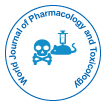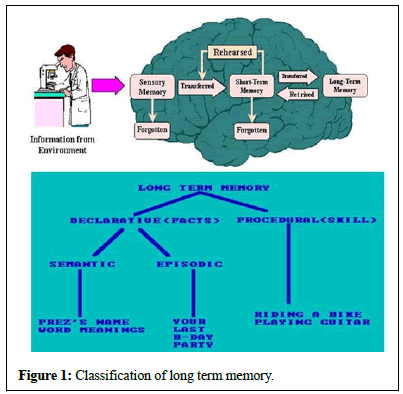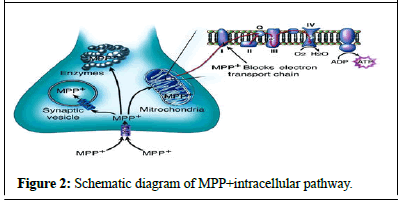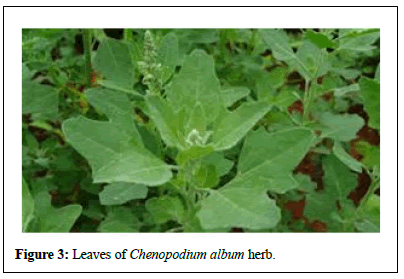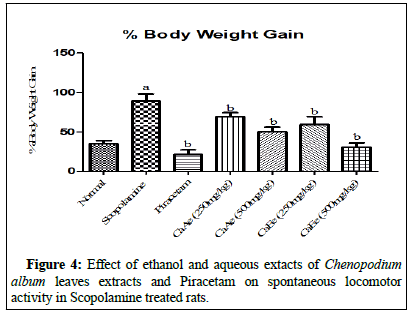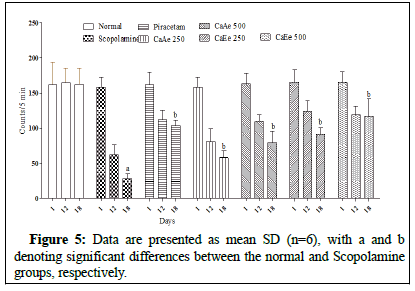Investigating the Potential for Memory Enhancer Activity in Wistar Rats Using Extracts from Chenopodialum album Leaves
Received: 02-Jan-2024 / Manuscript No. WJPT-24-124320 / Editor assigned: 04-Jan-2024 / PreQC No. WJPT-24-124320 (PQ) / Reviewed: 18-Jan-2024 / QC No. WJPT-24-124320 / Revised: 10-Apr-2025 / Manuscript No. WJPT-24-124320 (R) / Published Date: 17-Apr-2025
Abstract
The frequent causes of dementia include Alzheimer’s disease (50%). Cognition deficits produced by cholinergic antagonism mimic the cognitive symptomology of Alzheimer’s disease. Scopolamine, a muscarinic receptor antagonist, is reported to impair Long Term Potentiation (LTP), and frequently used as amnesic agent for evaluation of antiamnesic effect of new drugs. Considering the adverse effects of synthetic drugs, there is search for natural remedies which are safe and effective. The World Health Organization (WHO) estimates that 80% of the world’s population presently uses herbal medicine for some aspects of primary health care, therefore, natural products may provide a new source of beneficial neuropsychotropic drugs provided they are adequately tested and their mechanisms are properly deciphered.
Various plants are being used in complementary and alternative medicines for nootropic activity. Attention is being focused on the investigation of the efficacy of plant-based drugs used in the traditional medicinal system because they are cheap, have little side effects and according to WHO, about 80% of the world population still rely mainly on herbal remedies.
The present work was under taken to evaluate the nootropic activity of Chenopodium album leaves extracts in scopolamine induce Alzheimer type Dementia in rats.
For the purpose ethanolic and aqueous extract of Chenopodium album leaves were prepared and screened for phytochemical constituents and nootropic activity.
For pharmacological activity Wistar rats weighing 150-200 g were randomly divided in to seven groups (n=6/ group). Group Ð served as normal control and received vehicle; group ÐÐ served as scopolamine control and received vehicle; group ÐÐÐ standard drug piracetam (150 mg/kg, i.p.); groups ÐV and V were administered with ethanolic extract of Chenopodium album leaves (250 and 500 mg/kg respectively, p.o.) and groups VÐ and VÐÐ received aqueous extract of Chenopodium album leaves (250 and 500 mg/kg respectively, p.o.). All treatments were given orally and intraperitoneal started after 14 days inject Scopolamine (except normal control group) and continued for 14 days along with Scopolamine.
Keywords: Wistar rats, LTP, Chenopodium album, Scopolamine, Nootropic activity
Introduction
A person's thoughts, knowledge, interpretation, understanding, and beliefs are all included in their internal and exterior mental processes, which are collectively referred to as cognition. Severe cognitive problems may result from damage to these areas. Globally, degenerative neurological disorders are a major contributor to memory loss and other cognitive problems. It does not differentiate between the sexes, yet it disproportionately affects the elderly [1,2]. Epilepsy patients often struggle with cognitive impairment due to either the disease itself or the medications used to treat it. Evidence suggests that nootropics may help with a variety of memory and focus issues. While Piracetam (PIM) research has focused mostly on its cognitive benefits, it has also been demonstrated to have anti-myoclonus and anti amnesic qualities in a variety of experimental conditions. The anticonvulsant phenytoin has been shown to impair learning and memory [3]. To avoid cognitive decline, it may be helpful to mix antiepileptic medication with nootropics. The majority of people with epilepsy will need lifelong treatment with antiepileptic medication. Because of this, it's possible that the nootropic drugs need thorough testing and long-term use.
Memory
Specifically "the mental representation and subsequent retrieval of perceptual experiences, mental representations, and other forms of information and experience". In psychology, memory refers to a person's recollection of previously learned material. Although early research on memory was undertaken in the philosophical realms, by the late nineteenth and early twentieth century, cognitive psychology paradigms were used to the study of memory [4]. As the growing discipline that represents the marriage of cognitive psychology and neuroscience, it has become one of the cornerstones of cognitive neuroscience in recent decades.
Classification based on time span
In cognitive psychology, we often talk about three types of memory: Sensory, working, and permanent (Figures 1 and 2). Data exchange across these databases is often known as
Figure 1: Classification of long term memory.
Figure 2: Schematic diagram of MPP+intracellular pathway.
Plant profile
White goosefoot diagram shown in Figure 3.
Figure 3: Leaves of Chenopodium album herb.
Botanical classification
Kingdom: Plantae
Sub-kingdom: Tracheobionta
Superdivision: Spermatophyta
Division: Magnoliophyta
Class: Magnoliopsida
Sub-class: Caryophyllidae
Order: Caryophyllales
Family: Amaranthaceae
Sub-family: Chenopodiaceae
Genus: Chenopodium
Species: Chenopodium album
Habitat: Chenopodium album may be found almost everywhere, with notable concentrations in areas with high levels of nitrogen in the soil (such as those in Africa, Australia, North America, and Oceania).
Materials and Methods
Chemicals and reagents
All the substances like chemicals, drugs and reagents that are used in the study were of analytical grade and procured from various manufacturers (Table 1).
| Chemical/Reagent | Company name |
|---|---|
| Ethanol | S D Fine Chemicals Limited, India |
| Sodium hydroxide | SD Fine Chemicals Limited, India |
| Phenolphthalein indicator | Qualigens Fine Chemicals Pvt. Ltd. |
| Topfer’s reagent | Qualigens Fine Chemicals, Pvt. Ltd. |
| Petroleum ether | RFCL Limited, India |
| Diethyl ether | RFCL Pvt. Ltd. |
| Glycerine | RFCL Limited, India |
| Sodium chloride | SD fine Chemicals Limited, India |
| Piracetam | Nootropil, USB India, Pvt. Ltd., Vapi, Gujarat. |
Table 1: List of chemicals and reagents.
Insoluble acid ash value
After adding the collected plant material's entire ash content to 25 ml of heated H2O and letting it steep for 15 minutes, they added 25% v/v HCl to a 100 ml beaker and let it freeze. Finally, they filtered the mixture using Whattman filter paper No. 44 (without ash) and rinsed the residue twice with hot water. The filter paper with the insoluble ash on it was burned in a sintered crucible at 1000 degrees Celsius [5,6]. Finally, the acid unsolvable ash content was determined by weighing the crucible and the leftovers using the following formula:
The percentage of acid insoluble ash is equal to (a/y) multiplied by 100.
Where, a=the weight of the leftovers or residual and y=the measured amount of powder in grammes.
Value of water soluble ash
Two grams of the powdered (air-dried) material was used to negotiate the whole ash value. After 5 minutes of boiling, the ash was completely dissolved. Unsolvable material was congested on ashless or ash-free filter paper, washed with hot distilled water, and burned for 15 minutes with 25 ml of distilled H2O below 4500 degrees Celsius. Ash that could be dissolved in water was calculated by subtracting the mass of the insoluble material from the total mass of the ash. The percentage of water-soluble ash was determined relative to an air-dried plant specimen using the following formula:
Ash value (percent) in water=(a/y) × 100
Water-soluble ash=total ash minus water-insoluble ash.
Where, a=the weight of the leftovers or residual and y=the measured amount of powder in grammes.
Chenopodium album leaves chemical tests
The following findings were obtained from micro-chemical testing on powdered Chenopodium album leaves:
Cellulose detection
Test with iodine: Under the microscope, powdered leaves put on glass slides and treated with iodine solution were studied.
Test with sulfuric acid: Under the microscope, powdered leaves put on glass slides and treated with iodine solution and sulphuric acid were studied.
Chitin detection
Test with iodine: To examine the powdered leaves, a solution of iodine was applied to a glass slide where they were placed.
Iodine and sulfuric acid dissolved in water test: The leaves were powdered, put on a glass slide, treated with a solution of iodine and sulphuric acid, and then examined using a microscope.
The phloroglucinol concentration Test+HCl: The leaf powder was placed on the glass slide. Phloroglucinol and concentrated pH. It was then cooked with a 1:1 solution of HCl and examined under a microscope [7].
Check for safranin: A glass slide was affixed with powdered leaves. Safranin was introduced, and its effects were studied under a microscope.
Fat and fixed oil detection
The chloroform procedure: A microscope was used to examine leaf powder that had been put on a glass slide and had a few drops of chloroform applied to it.
Suberin and cutin detection, version
Test with iodine: A glass slide with some powdered leaves on it was placed in some iodine solution and examined under a microscope.
Test with sulfuric acid: The powdered leaves were placed on a glass slide and examined under a microscope after being treated with a solution of iodine and sulphuric acid.
Test for red in Sudan: To examine the powdered leaves, a solution of Sudan Red III was applied to a glass slide and then examined under a microscope [8].
Tannin detection
Examine with ferric chloride: The sample drug's powdered leaves are placed on a glass slide, and a few drops of ferric chloride solution are added before being examined under a microscope.
Starch detection
Test with iodine: Leaves were ground into a powder, placed on a glass slide, and then examined under a microscope after being treated with a drop of iodine solution.
Animals used in tests
Male wistar rats weighing between 150 and 200 g were used for the nootropic activity study after receiving approval from the institutional animal care and use committee. These rats were kept in the animal house at department of pharmaceutical sciences Kumaun University, Nainital for this purpose [9]. Every animal will be given 7 days to acclimatise under standard husbandry circumstances, with an average temperature of at a constant 25°C (77°F), relative humidity of 45–55 percent, and a light/dark cycle of 12 × 12 hours (or ambient temperature). Each useful group or team will form its own animal team and ensure that no animals in it are simultaneously applying for jobs in other departments. The animals will spend 48 hours becoming used to the laboratory environment. Before the standard operating procedure for skeletonizing if someone is under duress of any kind. All animal care techniques complied with CPCSEA regulations as out by the government of India's ministry of forest and environment [10].
Group 1: Normal control: Normal rats were maintained on standard chow diet and water ad libitum.
Group 2: Scopolamine control/negative control: Scopolamine (3 mg/kg; i.p.) for 14 days to impair learning and memory (Alzheimer diseases) [11].
Group 3: Standard/positive control (+Scopolamine): Piracetam (standard drug) (150 mg/kg; i.p.) was administered once daily for 14 days along with Scopolamine.
Group 4: Test group I (Scopolamine+CaEe 250 mg/kg; p.o.): Once daily for 14 days along with Scopolamine [12].
Group 5: Test group II (Scopolamine+CaEe 500 mg/kg; p.o.): Once daily for 14 days along with Scopolamine.
Group 6: Test group III (Scopolamine+CaAe 250 mg/kg; p.o.): Once daily for 14 days along with Scopolamine [13].
Group 7: Test group IV (Scopolamine+CaAe 500 mg/kg; p.o.): Once daily for 14 days along with Scopolamine.
Results and Discussion
Plant authentication
A coupon specimen of Chenopodium album leaves obtained in Haldaur, Uttar Pradesh, was identified and the drug was authenticated from the National Ayurveda Dietetics Research Institute, Bangalore.
Macroscopical characters
The following macroscopical characters of Chenopodium album leaves were observed (Table 2).
| S. no. | Organoleptic characters | Observations |
|---|---|---|
| 1 | Size | 3-7 cm long, 3-6 cm, wide |
| 2 | Color | Light to silvery or dark green |
| 3 | Surface characteristics | Smooth surface |
| 4 | Oder | Indistinct |
| Taste | Bitter and astringent |
Table 2: Observations of macroscopical characters.
Chemical constituents present in Chenopodium album leaves
Leaves powdered from Chenopodium album were subjected to a battery of micro-chemical analyses, the results of which revealed the presence of cellulose, chitin, fixed oils and fats, suberin, sudan red cutin, tannins, starch, mucilage, proteins, calcium oxalate crystals, cellulose cell wall, and calcium carbonate (Table 3) [14,15].
| No. | Constituents | Test | Observation | Inference |
|---|---|---|---|---|
| 1. | Cellulose | Iodine solution | Pale yellow color | + |
| Iodine solution+Sulphuric acid | Bright blue color | - | ||
| 2. | Chitin | Iodine solution | Deep blue color | + |
| Iodine solution+Sulphuric acid | Brown color | + | ||
| Safranin | Red color | + | ||
| Phloroglucinol+Conc. HCl | Phloem fibers stained red color |
+ | ||
| 3. | Fixed oils and fats | Chloroform | Soluble | + |
| 4. | Suberin, Sudan red Cutin |
Iodine solution | Deep yellow color | + |
| Iodine solution+Sulphuric acid | Deep brown color | + | ||
| Iodine+Sudan red III solution | Red color | + | ||
| 5. | Tannins | Dilute ferric chloride solution | Blue black color | - |
| 6. | Starch | Iodine solution | Blue color | + |
| 7. | Mucilage | Methylene blue | Deep blue color | + |
| Iodine solution+Sulphuric acid | Violet color | + | ||
| 8. | Proteins | Iodine solution | Yellow crystalloids | + |
| Alcoholic picric acid solution | Yellow crystalloids | + | ||
| Million’s reagent | Yellow color | + | ||
| 9. | Calcium oxalate crystals |
Powdered plant material+Acetic acid | Dissolved hydrochloric acid Insoluble acetic acid |
+ |
| 10. | Cellulose cell wall | Iodine and sulphuric acid solution | Blue violet colors | + |
| 11. | Calcium carbonate | Acetic acid | Dissolve with acetic acid | - |
Table 3: Micro-chemical constituents of Chenopodium album leaves.
Physicochemical characters
Total ash contents of Chenopodium album leaves: By deducting the full crucible's weight from the empty crucible's weight, the plant's entire ash value could be determined [16]. Chenopodium album has a total ash value of 12 mg/g (Table 4).
|
Weight of drug |
Weight of |
Ash obtained (g) |
Total ash |
|
|---|---|---|---|---|
|
14.00 |
2 |
14.24 |
0.24 |
24/2=12 |
|
Note: Results are the means of three observations of drug sample. |
||||
Table 4: Total ash value.
Value of acid insoluble ash of Chenopodium album leaves: The acid unsolvable ash of the leaves was calculated as subtracting total ash from wt. of crucible and weigh of unsolvable acid ash. The Chenopodium album leaves acid unsolvable ash was find out that is 8.5 mg/g (Table 5) [17].
| Weight of crucible (g) |
Weight of drug (g) | Total ash (g) | Ash insoluble ash obtained (g) | Ash insoluble ash (mg/g) |
|---|---|---|---|---|
| 14.00 | 2 | 0.24 | 0.17 | 8.5 |
| Note: Results are the means of three observations of drug sample. | ||||
Table 5: Acid-insoluble ash.
Water soluble ash content of Chenopodium album leaves: The water soluble ash of the plant was calculated by subtracting total ash from wt. of crucible and weigh of soluble ash in water. The Chenopodium album leaves ash which is soluble in water found to be 4 mg/g (Table 6 and Figures 4,5) [18-20].
| Weight of crucible (g) | Weight of drug (g) | Total ash (g) ‘A’ | Weight of water insoluble ash (g) ‘B’ | Water soluble ash obtained (g) ‘A-B’ | Water soluble ash (mg/g) |
|---|---|---|---|---|---|
| 14.00 | 2 | 0.24 | 0.16 | 0.08 | 4 |
| Note: Results are the means of three observations of drug sample. | |||||
Table 6: Water soluble ash.
Figure 4: Effect of ethanol and aqueous extacts of Chenopodium album leaves extracts and Piracetam on spontaneous locomotor activity in Scopolamine treated rats.
Figure 5: Data are presented as mean SD (n=6), with a and b denoting significant differences between the normal and Scopolamine groups, respectively.
Conclusion
In conclusion, this study into the potential memory-enhancing effects of Chenopodium album leaf extracts in Wistar rats has provided promising insights. The experimental data suggests that the extracts possess bioactive compounds that might positively influence cognitive functions. Through a series of behavioral tests, including the Morris Water Maze and Y-Maze, significant improvements were observed in the spatial learning and memory retention of rats administered with these extracts compared to the control group. These findings indicate that Chenopodium album could potentially be harnessed as a natural memory-enhancing agent.
However, it is crucial to acknowledge the need for further research to confirm these results and understand the underlying mechanisms. Future studies should aim to identify the specific compounds responsible for these effects and investigate their pharmacokinetics and pharmacodynamics. Additionally, exploring the long-term effects and safety profile of Chenopodium album extracts will be essential to evaluate their practical applications in cognitive health.
Overall, this research lays a foundation for the development of novel memory enhancement strategies derived from natural sources. It opens avenues for future investigations into herbal remedies for cognitive support, potentially leading to new therapeutic options for memory-related disorders. As always, translating these findings into clinical practice will require rigorous validation through human trials to ensure efficacy and safety.
References
- Lanni C, Lenzken SC, Pascale A, Del Vecchio I, Racchi M, et al. (2008) Cognition enhancers between treating and doping the mind. Pharmacol Res 57: 196-213.
[Crossref] [Google Scholar] [PubMed]
- Michael S (2006) The Ethical Brain: The Science of Our Moral Dilemmas (PS). NY: Harper Perennial. pp. 184.
- Giurgea C (1972) Vers une pharmacologie de l’activité integrative du cerveau. Tentative du concept nootrope en psychopharmacologie. Actual Pharmacol 25: 115-156.
- Lauralee S (2015) Human Physiology: From Cells to Systems. Cenga Learning, pp. 157-162.
- Eysenck MW (2012) Fundamentals of cognition. New York: Psychology Press.
- Baddely A (2007) Working memory, thought, and action. Oxford, UK: Oxford University Press.
- LaBar KS, Cabeza R (2006) Cognitive neuroscience of emotional memory. Nat Rev Neurosci 7: 54-64.
[Crossref] [Google Scholar] [PubMed]
- Adolphs R, Cahill L, Schul R, Babinsky R (1997) Impaired declarative memory for emotional material following bilateral amygdala damage in humans. Learn Mem 4: 291–300.
[Crossref] [Google Scholar] [PubMed]
- Cahill L, Babinsky R, Markowitsch HJ, McGaugh JL (1995) The amygdala and emotional memory. Nature 377: 295–296.
[Crossref] [Google Scholar] [PubMed]
- Kalat JW (2001) Biological psychology (7th ed.). Belmont, CA: Wadsworth Publishing.
- Papassotiropoulos A, Wollmer MA, Aguzzi A, Hock C, Nitsch RM, et al. (2005) The prion gene is associated with human long-term memory. Hum Mol Genet 14: 2241-2246.
[Crossref] [Google Scholar] [PubMed]
- Dudai Y (2007) Memory: It's all about representations. In: Roediger, H. L., Dudai, Y. and Fitzpatrick S. M., eds. Science of Memory: Concepts. New York: Oxford University Press, pp. 13–16.
- Semon R (1904) Die Mneme. Leipzig: Wilhelm Engelmann.
- Moscovitch M (2007) Memory: Why the engram is elusive? In: Roediger HL, Dudai Y, Fitzpatrick SM, eds. Science of Memory: Concepts. New York: Oxford University Press, pp. 17–21.
- Byrne JH (2007) Plasticity: new concepts, new challenges. In: Roediger HL, Dudai Y and Fitzpatrick SM, eds. Science of Memory: Concepts. New York: Oxford University Press, pp. 77–82.
- Ofengenden T (2014) Memory formation and belief. Dialogues in Philosophy, Mental and Neuro Sciences 7: 34–44.
- Jensen O, Lisman JE (2005) Hippocampal sequence-encoding driven by a cortical multi-item working memory buffer. Trends Neurosci 28: 67-72.
[Crossref] [Google Scholar] [PubMed]
- Eichenbaum H, Yonelinas AP, Ranganath C (2007) The medial temporal lobe and recognition memory. Annu Rev Neurosci 30: 123-152.
[Crossref] [Google Scholar] [PubMed]
- Suzuki WA (2007) Working memory: Signals in the brain. Science of Memory: Concepts. New York: Oxford University Press, pp. 147–150.
- LeDoux JE (2007) Consolidation: Challenging the traditional view. Science of Memory: Concepts. New York: Oxford University Press, pp. 171–175.
Citation: Malik R (2025) Investigating the Potential for Memory Enhancer Activity in Wistar Rats Using Extracts from Chenopodialum album Leaves. World J Pharmacol Toxicol 08: 297.
Copyright: © 2025 Malik R. This is an open-access article distributed under the terms of the Creative Commons Attribution License, which permits unrestricted use, distribution and reproduction in any medium, provided the original author and source are credited.
Select your language of interest to view the total content in your interested language
Share This Article
Open Access Journals
Article Usage
- Total views: 287
- [From(publication date): 0-0 - Dec 09, 2025]
- Breakdown by view type
- HTML page views: 201
- PDF downloads: 86
